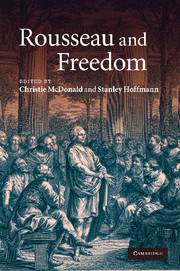Book contents
- Frontmatter
- Contents
- List of illustrations
- Notes on contributors
- Acknowledgments
- List of abbreviations
- Introduction
- PART I
- PART II
- 7 The Social Contract, or the mirage of the general will
- 8 “Par le bon usage de ma liberté”: freedom and Rousseau's reconstituted Christianity
- 9 The constraints of liberty at the scene of instruction
- 10 “Toutes mes idées sont en images”: Rousseau and the yoke of necessity
- 11 Rousseau's ruins
- 12 Can woman be free?
- 13 The subject and its body: love of oneself and freedom in the thought of Rousseau
- PART III
- Bibliography
- Index
11 - Rousseau's ruins
Published online by Cambridge University Press: 05 May 2010
- Frontmatter
- Contents
- List of illustrations
- Notes on contributors
- Acknowledgments
- List of abbreviations
- Introduction
- PART I
- PART II
- 7 The Social Contract, or the mirage of the general will
- 8 “Par le bon usage de ma liberté”: freedom and Rousseau's reconstituted Christianity
- 9 The constraints of liberty at the scene of instruction
- 10 “Toutes mes idées sont en images”: Rousseau and the yoke of necessity
- 11 Rousseau's ruins
- 12 Can woman be free?
- 13 The subject and its body: love of oneself and freedom in the thought of Rousseau
- PART III
- Bibliography
- Index
Summary
Jean-Jacques Rousseau (1712–1778) was buried in the gardens of the marquis de Girardin at Ermenonville, and his remains were solemnly laid to rest in a monument designed by Hubert Robert, an artist known primarily for his vast and impressive production of ruin paintings. The tomb was erected in the vicinity of the garden's most impressive folly, the Temple of Philosophy, which Girardin had modeled on the remains of the Sibyl's temple at Tivoli, and which he had deliberately constructed as a ruin to indicate the incomplete nature of the philosophical project. Heavy blocks of stone lay scattered around its base, redeemed only by a motto, “Qui l'achèvera?” (Who will complete it?), expressive of the hope that the future might salvage the ruined state of humanity.
By the late eighteenth century, as Rousseau's final resting place suggests, ruins had become fashionable in Europe as objects of artistic representation and philosophical contemplation. There was no greater chic than to erect a broken Roman column, genuine or ersatz, in one's garden. But if ruins were designed to stir the soul and elevate the mind, they also served as the impetus for political commentary. As the century neared its end, the ruins of the ancient civilizations of Greece and Egypt became the object of increasingly numerous literary and artistic representations, almost invariably coupled with scorn for the decadence of their present-day descendants and a glorification of the political and cultural strengths of the expanding European empires.
- Type
- Chapter
- Information
- Rousseau and Freedom , pp. 193 - 206Publisher: Cambridge University PressPrint publication year: 2010

